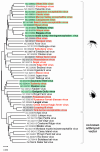Zoonotic Orthoflaviviruses Related to Birds: A Literature Review
- PMID: 40732099
- PMCID: PMC12297952
- DOI: 10.3390/microorganisms13071590
Zoonotic Orthoflaviviruses Related to Birds: A Literature Review
Abstract
Orthoflaviviruses (formerly flaviviruses) are known for their role in numerous diseases affecting both humans and animals. Despite the worldwide distribution of orthoflaviviruses, individual species are only found in endemic or epidemic regions. However, in recent decades, certain orthoflaviviruses have spread beyond their traditional geographic boundaries, even crossing continents. Given the long-distance movements of birds, the knowledge of zoonotic orthoflaviviruses associated with birds is essential because of their possible introduction into new regions, as was the case with West Nile virus and Usutu virus. A thorough literature review was conducted on zoonotic orthoflaviviruses related to birds, including lesser-known (re-)emerging and neglected orthoflaviviruses that are limited to specific regions and/or avian hosts but have the potential to spread to a wider geographical area and pose a higher risk of transmission to humans. Several of these viruses possess significant zoonotic potential and can cause a wide spectrum of diseases in humans, ranging from mild febrile illnesses (Zika virus) to severe neuroinvasive diseases (tick-borne encephalitis, West Nile, Japanese encephalitis virus) and hemorrhagic fevers (yellow fever, dengue virus). Geographic distribution, hosts, vectors, incidence of human infections, and impact on human and animal health of zoonotic flaviviruses related to birds are critically reviewed. The viruses have been categorized based on the role of birds as an orthoflavivirus host and the clinical presentation in human infections.
Keywords: birds; epidemiology; orthoflavivirus; zoonotic.
Conflict of interest statement
The authors declare no conflicts of interest.
Figures


References
-
- Postler T.S., Beer M., Blitvich B.J., Bukh J., de Lamballerie X., Drexler J.F., Imrie A., Kapoor A., Karganova G.G., Lemey P., et al. Renaming of the Genus Flavivirus to Orthoflavivirus and Extension of Binomial Species Names within the Family Flaviviridae. Arch. Virol. 2023;168:224. doi: 10.1007/s00705-023-05835-1. - DOI - PubMed
-
- ICTV Genus: Orthoflavivirus. [(accessed on 23 April 2025)]. Available online: https://ictv.global/report/chapter/flaviviridae/flaviviridae/orthoflaviv....
Publication types
LinkOut - more resources
Full Text Sources

